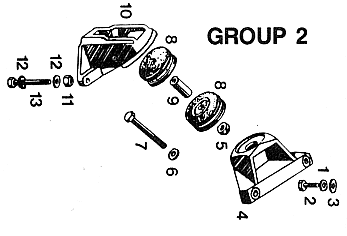...The Drawing is a 'Parts Diagram', it is NOT a 'Assembly Blueprint'. The Assembly in the Photo Is Correct!
I took out parts 9, 7, 6, and 5, The Sleeve and 12mm Bolt, and replaced it with a 3/4" Grade 8 Bolt, Eliminating the Sleeve/Spacer*. New Nyloc Nuts and the Largest, Thickest Washers I could come up with, as 'Load Spreaders', Under the Bolt Head and the Nuts, (4) Washers. I deemed the 'Stand-Off' from the Sleeve, Not Necessary. Torque? Tighten Until (I) Feel it's Right.
* The 'Sleeve/Spacer', does Not prevent 'Over-Torqueing' of the Nut/Bolt! What the Sleeve DOES, is Prevent Over-CLAMPING of the Entire Assembly. So in use as the Rubber Biskets get 'Mashed', the Assembly becomes Loosened and No Adjustment to Re-tighten! Then Your Engine WILL Wobble!! With the 3/4" Bolt, I tighten the entire clamping assembly, Very 'Snug' plus a Little Tighter. And this can be Re-Tightened, as needed, into the Future.
...A Tip: If One Plans to re-use their Rubbers, they will find the Bisket that was on the Bottom, with the Engines Weight, for Decades, has become Much Thinner than the Top Piece. Causing the Engine to Angle Downward in Front. Upon Reassembly, switch them with the thickest on the Bottom, thinnest on the top and You will see the Engine is sitting perfectly Level, in it's Bay. It Worked for Me.
MJ
...I do have the Original PAIR of Bolts and Sleeves, parts #9, #7 and #5 two nyloc nuts. (6) Six Pieces. for sale to anyone who may need them. Used and Rusty. PM Me




